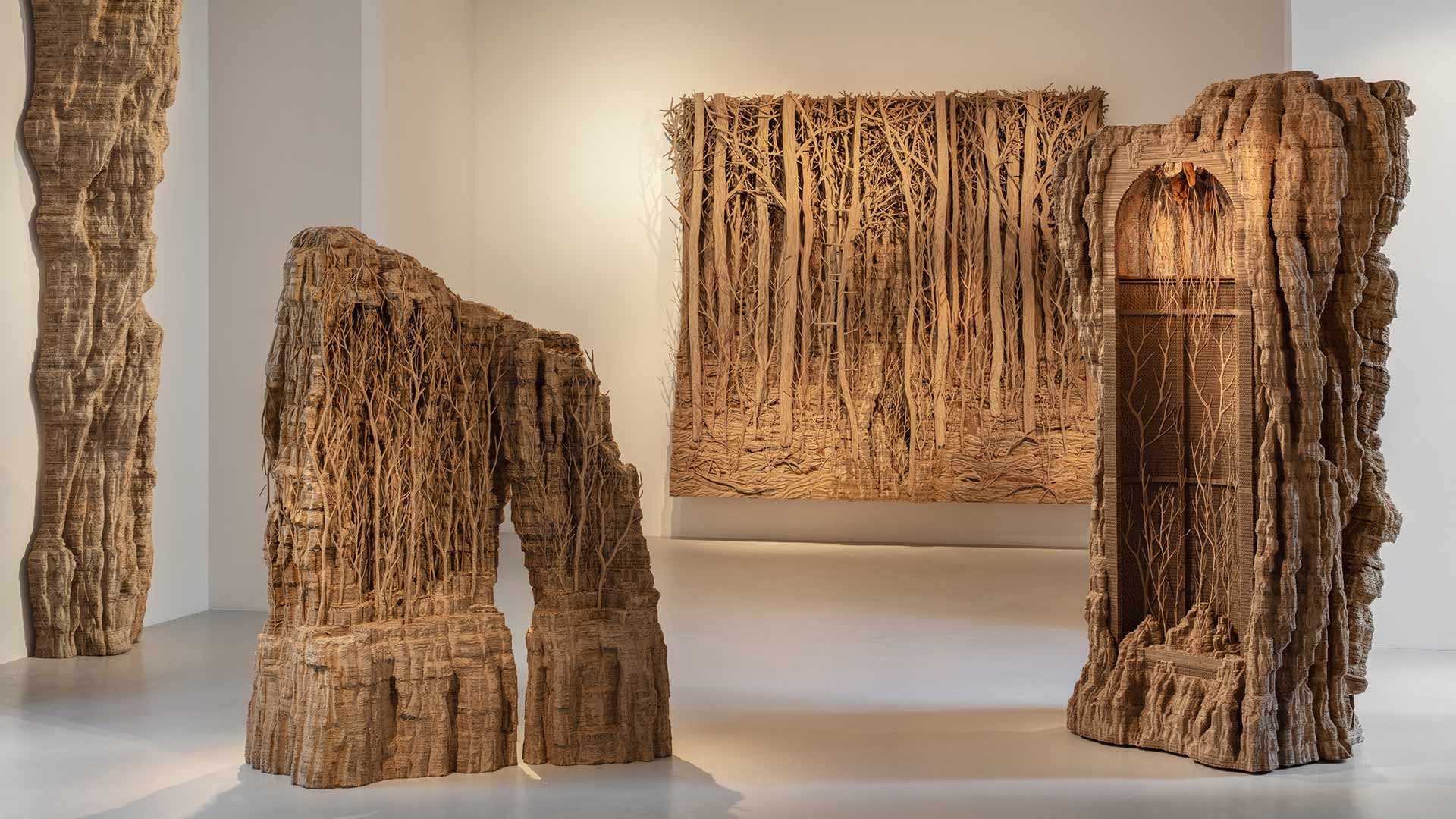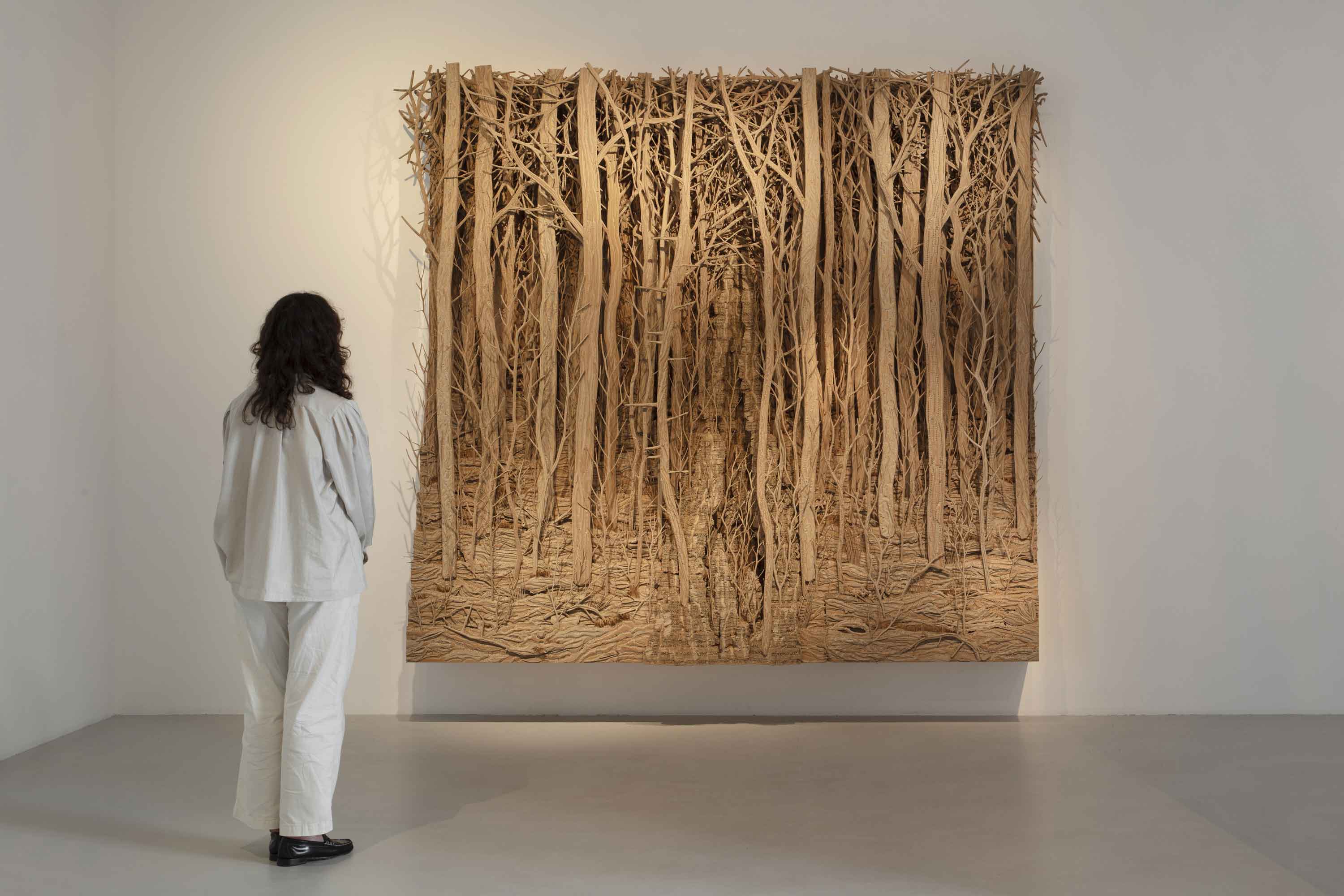Galleria Continua is delighted to present for the first time in its Paris venue Eva Jospin’s Tromper L'Oeil, an exhibition celebrating the first year of collaboration with the artist.
Eva Jospin has been sculpting and working with cardboard for some fifteen years, leaving a lasting and enduring mark on the French contemporary art scene. Tromper L'Oeil is part of a year rich in events for the artist, who is notably exhibiting at the Museo Fortuny in Venice (Selva), in parallel with the 60th edition of the contemporary art biennial, as well as at the Orangerie du Château de Versailles this summer.
Located on the first floor of the gallery, the exhibition brings together recent and previously unseen works created specifically for the occasion. Gathering themes dear to the artist, a variety of techniques are explored: from her emblematic cardboard forests and architectures to her drawings, embroideries and bronzes, as well as a new series of works unveiled to the public for the first time.
The title of the exhibition refers to trompe-l’oeil, a figurative pictorial genre that has existed since antiquity, which became very popular during the Renaissance. The story of its origins, narrated by Pliny the Elder, tells of a rivalry between two painters, leading them to create works so realistic that one succeeded in deceiving nature and the other in misleading his rival.
Tromper L'Oeil then comes from the artist’s pleasure in playing with reality, and the visitor’s pleasure in being surprised and carried away by the illusion. The exhibition space becomes a theatre stage, where the artifice is revealed step by step. The eye continually gets lost, is fooled and fascinated; it is impossible for it to embrace all the details and enigmas along the way.
The artist’s works are figurative, but the representation is never intended to be narrative. Eva Jospin invites the visitors to wander, contemplate, imagine and construct their own narrative. In Tromper l’oeil, we stroll through woods and fossil forests, but also through Renaissance gardens, nymphaeums and ancient caves. These influences come not only from fairy tales and mythology, but above all from a rich artistic culture that spans the centuries and graphic and sculptural representations. In a constant interplay of scale, the artist sculpts, cuts and carves the cardboard to assemble her Promontory, a majestic sculpture constituting a masterpiece (in reference to the piece that an apprentice must create to become a master of his craft). A gazebo, a grotto and a labyrinth rise in the space, linked together by an aqueduct and a bridge, inviting visitors to give free rein to their imagination. Eva Jospin’s work is built up from an accumulation of multiple layers of cardboard, which she sculpts by addition, gradually creating volume. She then focuses on the ornamentation and the profusion of details. The cardboard is transformed into rock, nymphs, filled with vines and other elements borrowed from nature.
This blend of nature and culture is also evident in her embroidered works. The artist evokes the splendid embroidery room in Rome’s Palazzo Colonna (discovered during her residency at Villa Medici), as well as the paintings of the Nabis and Édouard Vuillard, where figures blend together with the background in an infinite profusion of details. The intertwining of coloured threads creates a rhythm, reminiscent of the abundance of lines in the artist’s ink drawings. The ink drawings, considered as proper artworks, also function as preparatory models for the embroideries, something which in art historic jargon referred to cartoon (cartone in Italian, which also has the meaning of cardboard). And so the circle is complete.
The drawings and the large embroidery presented in the exhibition are preparatory and smaller versions of the monumental embroidered panels that will be unveiled during the artist’s show at the Orangerie of Versailles. Eva Jospin will indeed present her very first embroidered work from 2021, La Chambre de soie (translated as 'The silk Chamber'), created for a Dior haute couture collection show, with two added panels to perfectly fit the space.
Throughout the exhibition, the forest can be seen multiple times in cardboard, bronze, and for the first time, in an embroidered high relief. The forest, related to the tales of our childhood, is above all a mental forest for the artist. It is place where we like to lose and find ourselves, gathering our fears and questions. The cardboard, left raw, puts the forest at the border of the industrial and natural world. Just a glance to the sides is enough to discern the subterfuges, spot the supports, realize the illusionary depth that halts at the wall, and thus witness the revelation of a diorama.
The bronze version, cast from a cardboard forest, has been brushed and waxed. The tangle of branches reveals the honeycomb structure of the cardboard matrix. The bronze, left unpolished, highlights the natural colour of the metal, recalling the reliquaries and sculptures commonly found in Asian temples, once again evoking the multiple inspirations summoned by the artist.
The embroidered version, the first of its kind to be unveiled to the public, is clothed in delicately coloured silk veils, and recreates the light filtering through the twigs. Here the artifice is twofold: the composition is both forest and cardboard. Until now, embroideries in the artist’s work had never left the plane, but now it bursts into space. In the forest or in the cave, the embroidery not only recalls the colours of the vegetation, but also its textures.
Tromper L'Oeil is a promenade rich in materials and techniques in which Eva Jospin guides us step by step, following the poetic meanders of her imagination.
Read more +
Read less -







 Sign in with email
Sign in with email











